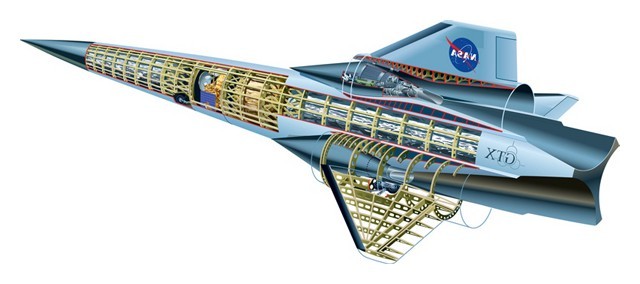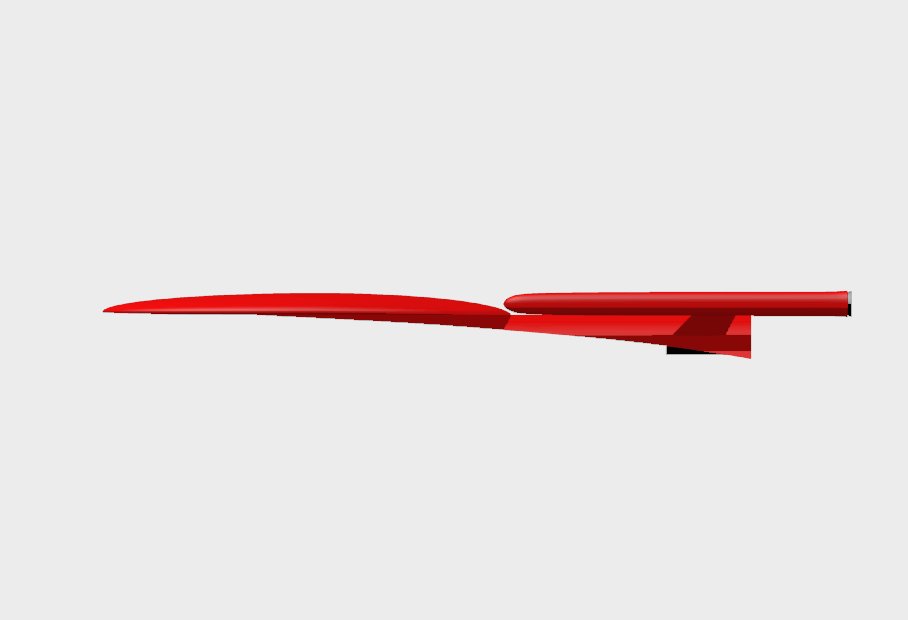
 |
|
|
(Under Construction)
Our hypersonic engines belong to a new type of hypersonic combustor/engines that we have developed as a replacement of engines and powertrains, like
- ram-/scramrockets,
- mechanical combinations of rockets and ram-/scramjet engin- es, and
- integrations of rockets and ram-/scramjet engines,
- mechanical combinations of aerospike and ram-/scramjet engines,
by using an aerospike engine instead of a rocket engine with bell nozzle that could be integrated with a ram-/scramjet engine.
Our hypersonic engines are built into our highly performant
- Hypersonic Jet Fighter (HJF) HJF-1 Hyper Falcon, and
- Hypersonic Cruise Vehicle (HCV) HCV-1/WhiteSwift,
- RLVs of the 3rd and 4th generation, and
- Space Shuttle Next Generation (NG) X-3033/MagicStar.
Introduction
Air-augmented rocket engines can be constructed by taking all diff- erent types of rocket engines, like for example aerospike engines.
A ramrocket/(conventional) ejector ramjet is an air-augmented ro- cket engine that uses the entrained air not only as working mass but also its oxygen part as propellant and is run with a fuel-rich rocket exhaust. Additional propellant can be injected in front of the rocket engine for a better mix with the incoming air, or/and behind it as an afterburner.
A rocket ejector ram-/scramjet engine is a Rocket-Based Combined Cycle (RBCC), which consists of a ramrocket, and a ramjet or a dual mode ramjet that are integrated into one engine. Basically, two vers- ions are realized that differ in the arrangement of the ramrocket in front or behind the ram-/scramjet engine. But despite the different construction options the RBCC works always in the same way: The air-augmented rocket engine has the function to accelerate the whole vehicle until the airflow in the air duct reaches the required velocity to ignite the ram-/scramjet engine. The standard concept operates until around Mach 2 as an air-augmented rocket and ramrocket/ejector ramjet, until around Mach 5 as a ramjet and at higher speeds as a scramjet engine. Around Mach 10 the scramjet is shut off, in many concepts the air inlet closed and the rocket reignited for a pure rocket mode.
NASA GTX/Trailblazer
The GTX/Trailblazer Single Stage to Orbit (SSTO) Reusable Air-Brea- thing Launch Vehicle (RABLV) reference concept by the National Ae- ronautics and Space Administration (NASA) has an RBCC powertrain with the rocket engine placed behind the air-breathing ram-/scram- jet engine with its main characteristic feature of an altitude-comp- ensating expansion surface for the exhaust streams of the thruster and the air-breathing engine, which are running as the so-called In- dependent Ramjet Stream (IRS). "In the first mode, valid from liftoff to about Mach 2.5, the engine operates in [the Independent Ramjet Stream] (IRS) cycle, where rocket thrust is initially used for primary power and as an ignition source for hydrogen fuel injected directly into the inlet air. Ignition and combustion of this fuel source, as well as unburned rocket fuel, results in the formation of a thermal throat in the nozzle and a ramjet mode of operation for the secondary stream. As the Mach number increases, the percentage of thrust due to the ramjet alone increases, and around Mach 2.5, the rocket motor is shut off and the engine shifts to a pure ramjet mode of op- eration (second mode). Around Mach 6, it becomes more practical to burn at supersonic speeds, and aided by centerbody translation, the engine shifts to a scramjet mode (third mode). The rocket is re-ig- nited around Mach 11 (fourth mode), the centerbody is translated to shut the inlet flow completely off, and the engine shifts to a rocket- only propulsion mode for the remainder of the ascent.", [National Aeronautics and Space Administration, Glenn Research Center: "Three Dimensional CFD Analysis of the GTX Combustor", NASA/TM-2002-211572, 2002].
Besides that this spacecraft is a very nice example for such a kind of RBCC, its main advantages are the expansion surface and that the rocket engine is also used as the substitution of the flame holder for the ramjet mode.
The main disadvantages of this special powertrain are its inefficiency due to the positioning of the rocket engine and the fuel injectors, a too short air duct, no afterburner, and the application of a translat- ing inlet centerbody, which adds extra weight and too much comple- xity especially inside the engine. Furthermore, for the GTX/Trailblazer SSTO RABLV reference concept it would be also advantageous to use only two engines instead of three, and as well more features of the air-breathing National Aero-Space Plane (NASP) prototyp X-30 and Lockheed Martin and partners SubOrbital Test Vehicle (SubOTV) X-33 and SSTO Reusable Rocket Launch Vehicle (RRLV) VentureStar, like the lifting body that yields in a different trajectory and a lower propellant consumption, and an airframe-integrated engine design, as we do with our X-3033 /MagicStar.
NASA Space Express
The Space Express is a similar Single Stage to Orbit (SSTO) Reusable Air-Breathing Launch Vehicle (RABLV) concept by the NASA like its GTX/Trailblazer with the main differences that it has a lifting body as its fuselage, features 8 air ducts, has its air ducts positioned only on the upper side of the fuselage, integrates the stream of a dual mode ramjet and an aerospike, does not apply the concept of a translating inlet centerbody, and the whole afterbody is sculptured as one ex- pansion surface instead of three single ramps.
The design is also a very nice example of such a spacecraft and already features some of the suggestions we mentioned in conjunct- ion with the SSTO RABLV reference concept GTX/Trailblazer, especially the lifting body with a more airframe-integrated engine design, and no translating inlet centerbody. Also, the emphasizing and integration of the aerospike concept belongs to its advantages.
But the other disadvantages still remain and thorough analyses in this field suggest that this design still has a lower efficiency for a SSTO spacecraft in comparison to a powertrain that is based on a pure rocket or an air-augmented rocket engine due to the weight and other keynumbers of the air-breathing engine modul. So it would be more advantageous to lengthen the air duct, rearrange the position of the aerospike engine, so that the aerospike enigne is between two air-breathing engine sections.
SHock-induced Combustion Ramjet (SHCRamjet)
One of the problems with the scramjet engine concept is associated with the slow rate of the hypervelocity diffusive burning in the com- bustor. A solution is to take a longer air duct or with an airframe-in- tegrated engine a longer combustion chamber, so that the fuel and the incoming air can be mixed in a more efficient way, and more of the energy of the mixture can be released. But this results in a more massive structure and a more complicated cooling system of the engine, which decreases the performance of the whole aerospace- craft.
Another solution for the elimination of this difficulty is the SHCRamjet concept that separates the mixing of the fuel and air, and the com- bustion processes. To accomplish this the fuel and air can be premix- ed in the flow at the forebody of a vehicle, which is the inlet of an aerospacecraft with airframe-integrated propulsion system, "taking care to avoid premature ignition of the premixed flow. Combustion can then be initiated by a conveniently located shock wave, gener- ated by a wedge or blunt body. The ensuing shock-induced combu- stion is very rapid and results in a very short and lightweight com- bustor."
The concept of the premixing process is not so new, but was focus- ed on the cooling effect of the propellant on the inlet as part of an thermal protection system. The two main difficulties associated with the SHCRamjet design are that the vehicle must be accelerated to supersonic speeds before the SHCRamjet engine can be started, and the need to "keep the detonation wave from propagating upstream and out of the engine inlet system" by an adjustable wedge or blunt body at a position where it is highly complex and the heat load is highest. Also, the application of different kinds of thermal protection systems could become more complex and difficult.
An advantage of this concept is that it fits perfectly with the spec- ific Continuous Detonation Engine (CDE) type called Oblique Deton- ation Wave Engine (ODWE).
From Aerospike Engine to Single Mode Hypersonic Engine
Due to the dimensions of a ram-/scramjet engine it is possible to use aerospike engines, in general. But alone by this small step we get several giant advantages:
Steps to the Revolution
The development started with the concept of the air-augmented aerospike engine (ram-/scramaerospike), especially in our concept of the linear version, and the requirement specification to reduce the complexity of the overall engine architecture. The result can be seen best by the main differences of the new class of hypersonic engines to the other rocket ejector ram-/scramjet engines, that are:
- five modes of a combined cycle (pure rocket, air-augmented rocket, ramrocket/ejector ramjet, pure ramjet and scramjet engine),
- one general type of rocket engine cycle (open or closed cycle),
- one special type of an open cycle (gas generator or expander bleed cycle),
- one special type of a closed cycle (staged combustion or expander cycle),
- two modes of a dual mode ramjet engine (ram- and scramjet engine) and
- two modes of spatial application (planetary atmosphere and space),
Combined Fuel Feed and Thrust Cell System
But these are not all of the advantageous technical implications, be- cause it is now possible to even push further the design of the ar- chitecture. Instead of a whole aerospike engine with its own housing and its own seperated nozzle ramp as an accelerator the new engine uses for its whole range of operation modes only the combination of
of a (linear) aerospike engine.
The fuel feed system of the hypersonic engine is optimally fitted and integrated into the thermal protection system of the aerospacecraft. It functions generally like fuel feed systems of classic rocket engines with the main differences that
- the inital phase as an open gas generator cycle,
- the start phase as an open gas generator and expander bleed cycle until enough heat for a staged combustion and expander cycle mode is available and
- in all operational ranges as open or closed cycle if a higher propellant efficiency or increased specific impulse is desired.
The thrust cell system of the engine uses the expansion ramp nozzle of a (linear) aerospike engine after reaching Mach 2 as its fuel in- jection nozzle. This has the effect that the flame/blaze (or the com- bustion chamber) is wandering/marching/moving through the hyper- sonic engine in relation to its velocity. Conceptually, this effect can be compared with the effect of open nozzles of aerospike engines and yields as well in higher performance and/or reduced consumpt- ion.
Integrated/Combined Propellant Thermal Protection System
The trick is to take the optimal steps for the boot(strap) process of the engine and its integration into one powertrain by finding the right propellant, and by simultaneously reducing the complexity as far as possible, especially at the sections of the fuel storage and fuel feed system where rotating hardware has to be used for pump- ing the propellant. Furthermore, an intelligent reformation of the propellant in the thermal protection system is mandatory.
To accomplish the goal, the propulsion system is ideally powered by one propellant only, but which is not a precondition for the general engine concept.
We prefer as propellants H2O2, H2O, bio and synthetic hydrocarbon based fuels, and their blends.
In practice the system is taking the following steps:
1. The initial step, when the vehicle is cold, is to burn one of the prefered propellants to produce heat and pressure for the extraction and decomposition of the H2O2 (hydrogen peroxide), which is stored safely in H2O. A standard turbine based on-board Auxillary Power Unit (APU) powered by a hydrocarbon based fuel can be applied for this.
2. After this, all the heat needed for running the turbopumps and all of the propellant for the start phase/first mode (formerly accelerat- or/rocket ejector mode) is available.
3. While flying with speeds until Mach 1.5, the needed heat is prod- uced by the autodecomposition of H2O2.
4. In the later phase, while flying above a velocity of 1.5 Mach, en- ough heat and electricity produced by MagnetoHydroDynamic (MHD) generators are available without the H2O2 decomposition for the de- composition of H2O. Also, H2O steam is always available for a hydro- carbon based fuel reformation with or without (as in the Leninets' case) water-gas shift reaction for CO reduction, if such a propellant is used.
5. At higher velocities the air drag at the front surface of the aero- or orbital spaceplane produces the heat, which is harnessed by the integrated propellant thermal protection system, for building up the needed pressure for driving the pumps, and for feeding the hyper- sonic engine with decomposed H2O2 and H2O (O and H2 gases), and reformed propellant directly into the scramjet combustor.
Internal and External Combustion
And we boldy go further. Due to the fact that the whole body of a hypersonic jet is the engine itself, our concept of an aerospike derived hypersonic engine architecture yields in more advantages, which have the results:
As the external combustion version the combustion chamber of the hypersonic engine must not exist (zero length). In this extreme version the combustion chamber of the hypersonic engine does not exist as a duct, but is bounded by a shockwave to the body of the hypersonic vehicle. Said with other words, the hypersonic engine is totally open.
Flight Control
Flight control at high speeds is provided by actively vectoring/ modulating the fuel flow to the propelling nozzles.
Further Considerations
We would like to coin the new hypersonic engine architecture:
At the end we believe that we will stay with the term scramjet or hypersonic only, and see our development as part of the evolution of this type of engines.
The Past







